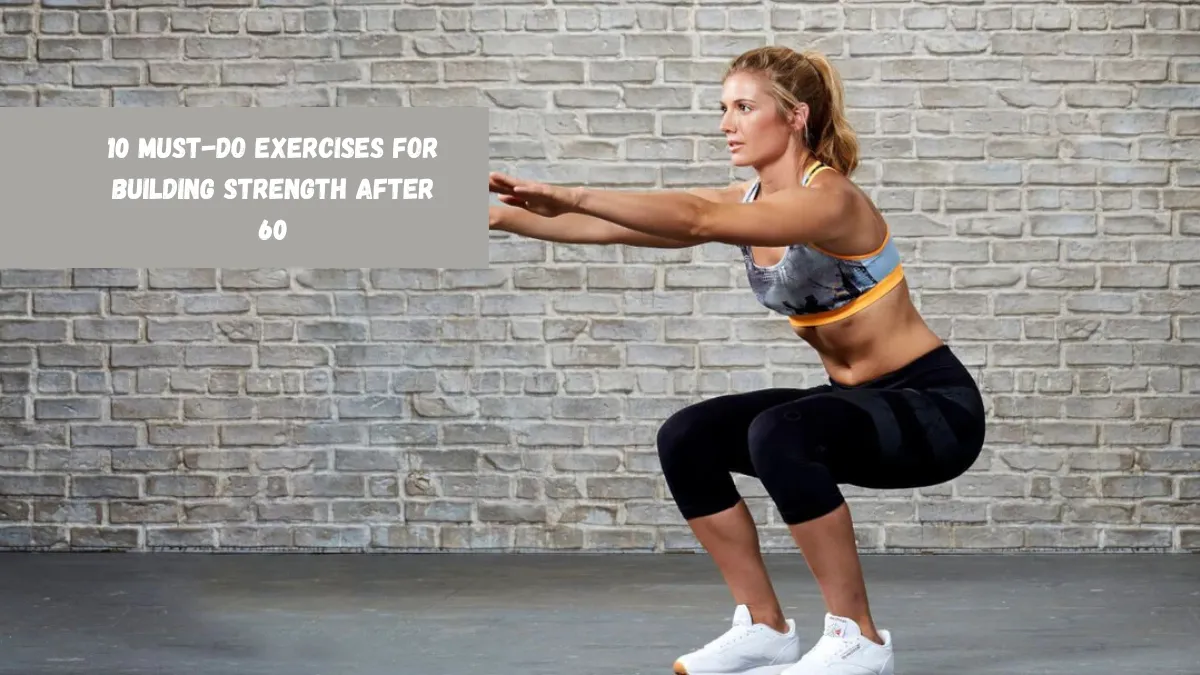Staying strong and active after 60 is one of the best ways to maintain independence, reduce the risk of falls, and enjoy a better quality of life. As we age, our muscles naturally weaken, but the good news is that it’s never too late to build strength. Simple, low-impact exercises can make a big difference in improving muscle tone, balance, and joint health. In this guide, we’ll cover 10 must-do exercises specifically designed for older adults.
These moves are safe, effective, and easy to perform at home with little or no equipment. Whether you’re a beginner or getting back into fitness after a break, these exercises will help you stay strong, flexible, and confident in your daily routine. Commit to a regular workout schedule, and you’ll feel stronger, more energetic, and better prepared to enjoy all the things you love. Let’s get started on building strength after 60—one step at a time.
1. Bodyweight Squats
Squats with your own body weight are one of the most useful workouts for people over 60. They make the legs, hips, and buttocks stronger and improve balance and movement all around. It is normal for muscle strength to decrease with age, especially in the legs. By strengthening the muscles you use for daily tasks like sitting, standing, and walking, squats can help you fight this loss and keep your freedom. Stand with your feet shoulder-width apart and your back straight. Lower your body as if you were sitting in a chair, making sure your knees don’t go past your toes.
Then slowly get back up. Aim for 10–15 reps per set, and do two to three sets, depending on how well you can do them. To keep yourself safe and steady, always start with a chair behind you. You can move your squats deeper or add light dumbbells for added support as you get stronger. Bodyweight squats also make joints more flexible, which is important for keeping mobile and lowering the risk of damage as you get older.
2. Wall Push-Ups
Wall push-ups are safer than regular floor push-ups, so they’re great for people over 60 who want to strengthen their upper bodies without putting too much stress on their joints. They work the core muscles and focus on the chest, shoulders, and arms. This helps with balance and body control in general. Stand with your back to the wall and your feet about two feet away. This is how you do wall push-ups. Lay your hands flat on the wall, shoulder-width apart and at shoulder height. Take small steps to bend your arms and move your chest toward the wall.
Then, push back to the starting position. Try to do 10 to 15 reps in each set. This low-impact practice strengthens muscles without putting too much stress on the arms and shoulders. Regular practice can help keep your upper body working well and lower your risk of falling by making you more stable. As you get better, you can make it harder by standing farther away from the wall or switching to push-ups on an angle against a counter or other stable surface.
3. Seated Leg Extensions
A safe way to build the quadriceps muscles in the front of your thighs is to do leg lifts while sitting down. Strong quads help support the knees, lower the risk of falling, and keep you able to stand up from a sitting position or climb stairs. It’s easy to do this practice, and you can do it while reading or watching TV. Place your feet flat on the floor and sit up straight in a strong chair. Lift one leg slowly until it is straight.
Hold it there for a moment, then lower it back down. Switch legs and do this 10–15 times on each side. You could use ankle weights or a resistance band to make the exercise harder. Seated leg extensions are great for adults with arthritis or knee pain because they keep muscles toned without putting too much stress on the joints. Regular practice not only makes the legs stronger, but it also improves blood flow, which helps keep muscles from losing their shape as people age.
4. Standing Calf Raises
Calf raises while standing are a simple but effective way to strengthen the lower legs, especially the calves, which are very important for walking, standing, and keeping your balance. It’s also important to have strong calf muscles because they help the blood flow in your legs, which can get worse with age. Hold on to a strong chair behind you while you do calf raises. Stand with your feet shoulder-width apart.
Then, slowly lift your heels off the ground until you’re on the balls of your feet. Stay here for a few seconds, and then slowly bring your heels back down. Do between 10 and 15 reps in a set. As your balance gets better, you can do the exercise without hanging on to anything or add light weights to make it harder. If you do this exercise daily, it can help you walk farther, keep you from tripping, and build the leg strength you need to live a busy, independent life after 60.
5. Chair Dips
Triceps, the muscles at the back of the upper arm, tend to get weaker with age. Chair dips are a great way to strengthen them. You can do this exercise at home with a strong chair that doesn’t have wheels. It also works the shoulders and chest. Place your hands on the sides of the chair and lean back. Your hips should be off the chair, so move your feet forward. Then, bend your elbows to about a 90-degree angle and lower your body.
Use your arms to push yourself back up to the starting position. Do 8–10 reps at first, and as you get better, do more. For everyday tasks like getting out of a chair or moving groceries, chair dips can help build the strength you need to push things. Watch out not to go too low if you have shoulder pain, and always sit in a chair that won’t move. If you do chair dips regularly, they can help you get toned arms and better upper body function.
6. Marching in Place
It is a low-impact cardio and power exercise that helps your heart stay healthy and makes your legs stronger. It also helps you improve your balance. It’s great for older people who might not feel safe going for long walks or doing activities with a lot of impact. As you march, stand tall with your feet hip-width apart and lift one knee toward your chest. Then, drop that knee and continue with the other leg.
If you need to, you can use a wall or chair for support. Aim to march continuously for one to two minutes at a time, and as you get stronger, slowly add more time. Moving back and forth while marching helps the body wake up, boost blood flow, and keep joints healthy. Additionally, it makes the hip flexors, legs, and calves stronger, which is important for keeping the ability to walk. This practice can help you keep your balance and lower your risk of falling. Anyone over 60 who wants to stay strong and active should do it every day.
7. Bird Dog Exercise
The bird dog move is a great way to make your core stronger, your balance better, and your timing better. It works the lower back, stomach, and gluteal muscles, which are very important for balance and body control in general. Get on all fours and put your hands exactly under your shoulders. Place your knees under your hips. Slowly move your left leg back and your right arm forward so that they are both parallel to the floor. Hold for a few seconds, then go back to the beginning and switch sides.
Do eight to ten reps on each side. This controlled movement makes you think about your balance and helps your core and back muscles get stronger without putting too much stress on your joints. The bird dog is especially good for adults with lower back pain because it helps keep the spine straight and engages the core. To avoid getting hurt, make sure to move slowly and carefully. If you do this exercise regularly, it can help you move and stay stable in everyday life.
8. Resistance Band Rows
Shoulder, arm, and upper back strength are important for good balance and everyday pulling movements. Resistance band rows are a safe and effective way to get stronger in these areas. This exercise is great for people over 60 because it is easy on the joints and can be done sitting down or standing up. Hold both ends of a resistance band with both hands and fix it at chest height. Squeeze your shoulder blades together and pull the band toward your body. Do not shrug your shoulders, and keep your back straight. After that, slowly move back to the starting position.
Do 10 to 12 reps in a set. Resistance band rows can help fix bad posture that comes from sitting and keep your back and neck from getting strained. They also support the muscles that help you move and carry things, which makes daily tasks easier. You can either use a tighter resistance band or do more sets as you get stronger. It’s a flexible workout that can be used in almost any training plan for seniors.
9. Step-Ups
Functional strength exercises like step-ups work the legs and make balance, agility, and aerobic endurance better. They make your quadriceps, hamstrings, and hips stronger, which is important for walking and climbing hills. This exercise should be done on a low, stable step or stairs. Step one foot up, then bring the other foot up to meet it. Step one foot back down, and do it again. Change which leg is in front of you and do 10 to 15 reps on each side. Always hold on to a fence, or if you need to, use a wall for support.
Step-ups are a great way for older people to keep their leg strength and balance because they are very similar to real-life moves. They also work the core, which helps with balance and stance. Start with a low step and only raise it when you’re sure you can handle it. Step-ups are a great way to keep your legs strong, avoid falling, and stay flexible well into your senior years.
10. Glute Bridges
Lower back, core, and gluteal muscles get stronger with glute bridges. These muscles are important for support, balance, and lowering lower back pain. Lay on your back with your knees bent and your feet flat on the floor, hip-width apart. This is the glute bridge. Keep your arms at your sides to help you. Squeeze your glutes and slowly lift your hips off the floor. Hold for a few seconds at the top, then slowly lower back down. Aim for 10 to 12 reps per set. This exercise is great for adults because it works muscles that get weak from sitting for long periods of time.
Getting stronger in the hips makes it easier to walk and keep your balance, which is important for doing daily chores. Glute bridges can also help keep your pelvis stable and take pressure off your spine. Move slowly and put down a mat to help you feel better. Glute bridges can help you build a strong lower body and lower your risk of falling and hurting your back if you do them regularly.
Bottom Line
Building strength after 60 doesn’t require a gym membership or complicated routines. With just a few simple exercises done consistently, you can improve your muscle strength, balance, and mobility. These 10 must-do exercises are ideal for older adults and focus on functional movements that support everyday activities. By taking just 15 to 30 minutes a few times a week, you can protect your independence, reduce injury risks, and boost your overall well-being. Always listen to your body, move at your own pace, and consult a healthcare provider if you have any medical concerns before starting. Stay active, stay strong.
FAQs
Why is strength training important after 60?
Strength training helps maintain muscle mass, bone density, and balance, reducing the risk of falls and injuries as we age.
How often should I do strength exercises each week?
Aim for at least two to three days per week, allowing time for rest and recovery between sessions.
Do I need equipment to build strength at home?
No, many effective exercises like squats, wall push-ups, and glute bridges use just your body weight.
Can beginners over 60 start exercising safely?
Yes, start with low-impact movements and simple routines. It’s always best to consult a doctor before beginning any new fitness plan.




